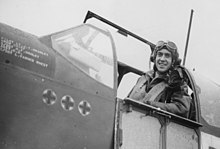
The 4th Fighter Group was an American element of the United States Army Air Forces (USAAF) Eighth Air Force during World War II. The group was known as the Debden Eagles because it was created from the three Eagle Squadrons of the Royal Air Force: No. 71, No. 121 Squadron RAF, and No. 133 Squadron RAF. These squadrons became the 334th, 335th, and 336th Fighter Squadrons of the 4th Fighter Group based at RAF Debden. The group was the first fighter group to fly combat missions over German airspace, the first to escort bombers over Berlin, and the first selected to escort bombers on shuttle bombing runs landing in Russia. The group was credited with shooting down 1,016 German planes.

The VIII Fighter Command was a United States Army Air Forces unit of command above the wings and below the numbered air force. Its primary mission was command of fighter operations within the Eighth Air Force. In the World War II European Theater, its primary mission was air superiority. Its last assignment was with the United States Air Forces in Europe at RAF Honington,

The 356th Fighter Squadron is an active United States Air Force fighter squadron. It is assigned to the 354th Fighter Wing, being stationed at Eielson Air Force Base, Alaska. It was reactivated in 2019 to operate the Lockheed Martin F-35 Lightning II.

The 353rd Combat Training Squadron is a United States Air Force training squadron responsible for Exercise RED FLAG – ALASKA held annually in Alaska.

Wah Kau Kong was the first Chinese American fighter pilot. Born in Honolulu, Hawaii, Kong became a chemist after graduating from the University of Hawaii and joined the United States Army Air Forces after the Attack on Pearl Harbor.

Royal Air Force Boxted or more simply RAF Boxted is a former Royal Air Force station located 4 miles (6.4 km) north-northeast of Colchester, Essex England.

The 357th Fighter Group was an air combat unit of the United States Army Air Forces during the Second World War. The 357th operated P-51 Mustang aircraft as part of the U.S. Eighth Air Force and its members were known unofficially as the Yoxford Boys after the village of Yoxford near their base in the UK. Its victory totals in air-to-air combat are the most of any P-51 group in the Eighth Air Force and third among all groups fighting in Europe.

The 359th Fighter Group was a United States Army Air Force fighter unit that was active during World War II. Following organization and training in the United States, the group deployed to the European Theater of Operations, operating from RAF East Wretham. The fighter group flew 346 combat missions over continental Europe and claimed 373 enemy aircraft in aerial combat and strafing attacks; probable destruction of 23; and damage to 185. It was awarded the Distinguished Unit Citation for its actions. The group flew its last mission on 20 April 1945, then returned to the United States for inactivation.
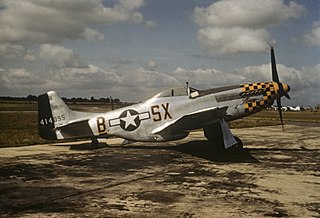
The 353rd Fighter Group, nicknamed the Slybird Group, was a fighter group of the United States Army Air Forces during World War II. The group was stationed in England and comprised the 350th, 351st, and 352nd Fighter Squadrons. It pioneered the P-47 dive-bombing and ground attack technique adopted by both Eighth and Ninth Air Forces. The group flew 447 combat missions and claimed 330 air and 414 ground aircraft destroyed. Group markings were black, yellow, black, yellow spinners, with a 48-inch black and yellow checker band around the cowling to the end of the exhaust stubs.

The 56th Operations Group is a unit of the United States Air Force, and the flying component of the 56th Fighter Wing.
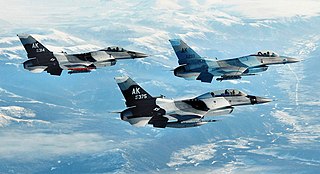
The 354th Operations Group is a component of the 354th Fighter Wing, assigned to the United States Air Force Pacific Air Forces. The group is stationed at Eielson Air Force Base, Alaska.

The 352nd Fighter Group was a unit of the Eighth Air Force that was located in the European Theater of Operations during World War II. The unit served as bomber escort, counter-air patrols, and attacking ground targets. It initially flew P-47 Thunderbolt aircraft before converting to P-51 Mustang in April 1944. The group was located at RAF Bodney in England for the majority of its service and were nicknamed the Blue-nosed Bastards of Bodney due to the distinctive blue of the nose and upper cowl of the P-51 Mustangs of the group.

Glenn Todd Eagleston was a career officer in the United States Air Force and the leading ace of Ninth Air Force in Europe in World War II. Eagleston was credited with 18 1/2 victories, two probable victories, and seven damaged German aircraft. He also destroyed at least five enemy aircraft on the ground, while flying P-51 Mustangs with the 354th Fighter Group.
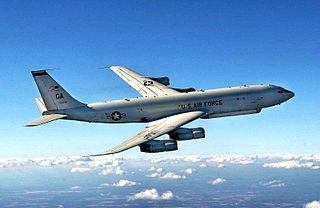
The 116th Operations Group is a Georgia Air National Guard unit assigned to the 116th Air Control Wing. The unit is stationed at Robins Air Force Base, Georgia. The 116th Group controls all operational Northrop Grumman E-8C Joint STARS aircraft of the 116th Air Control Wing. It was activated in 1992, when the Air Force implemented the Objective Wing organization, and was successively equipped with the McDonnell Douglas F-15 Eagle and the Rockwell B-1 Lancer before converting to the E-8C in 2002.

Glenn Emile Duncan was a career officer in the United States Air Force and one of the leading aces of Eighth Air Force in World War II in Europe and the top ace of the 353rd Fighter Group. Duncan was credited with 19.5 victories, one probable victory, and seven damaged German aircraft. He also destroyed at least nine enemy aircraft on the ground, while flying P-47 Thunderbolts with the 353rd Fighter Group. He flew combat missions in the P-47 Thunderbolts and P-51 Mustangs in Europe.

Jack Tarleton Bradley was a United States Army Air Forces flying ace who was credited with shooting down 15 aircraft during World War II, being awarded the Distinguished Service Cross and the Distinguished Flying Cross for his actions. He served as commanding officer of the 353rd Fighter Squadron.
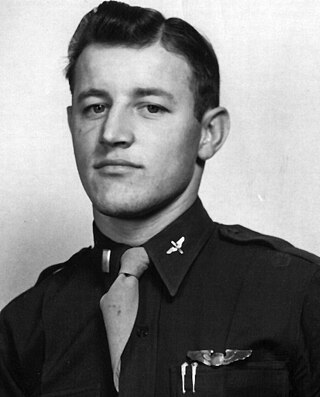
Don Merrill Beerbower was a United States Army Air Force fighter ace who was credited with shooting down 15.5 aircraft during World War II.
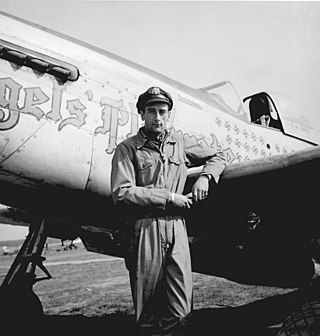
Bruce Ward Carr was a highly decorated United States Air Force colonel. During World War II, he was shot down over Germany and, after evading capture for several days, snuck into a Luftwaffe airfield and stole an enemy plane which he flew back to Allied lines. He also became a flying ace credited with 14 or 15 aerial victories, including five in a single day, for which he was awarded the Distinguished Service Cross.
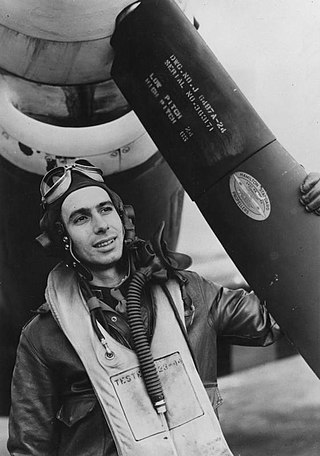
Wallace Nathan Emmer was a United States Army Air Force fighter ace who was credited with shooting down 14 aircraft during World War II. He was also the one of the first pilots to fly a combat mission in the P-51 Mustang.
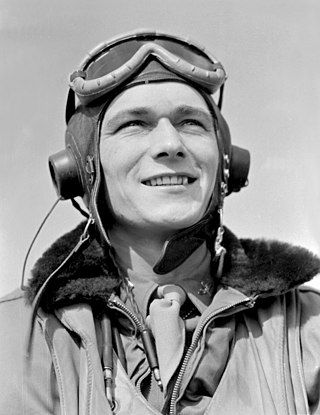
Donald Septimus Bryan was an American flying ace in World War II, who was credited with 13 aerial victories while serving with the 352d Fighter Group.
354th Fighter Group - History of the Pioneer Mustang Fighter Group During World War II http://www.354thpmfg.com/


